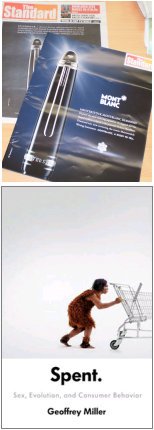Mid-Levels residents trundling down the hill on the famous Escalator this morning receive their free copies of the Standard wrapped in a glossy cover publicizing something called the Meisterstuck Montblanc Diamond, with the zippy slogan ‘Excellence at the tips of your fingers’. According to the blurb, it’s a “black precious resin writing instrument … adorned with platinum plated fittings and a handcrafted 14k gold nib with a rhodium-plated inlay.” (Out of academic curiosity, I took the bait. Rhodium (Rh, atomic number 45) is a platinum-like metal currently trading at around double the price of gold. Its only tasteful use is in catalytic converters.)
 But wait! There’s more! “Simultaneously,” the copy continues, “the Montblanc Diamond is gracefully featured in the dome, as if suspended in mid-air.”
But wait! There’s more! “Simultaneously,” the copy continues, “the Montblanc Diamond is gracefully featured in the dome, as if suspended in mid-air.”
So desperate are the manufacturers to get this tackiness in our faces that even removal of the wraparound offers no escape: the Standard has prostituted its front page to the jewel-encrusted pen.
I once received a Montblanc in a fancy beribboned box at a function where everyone had giant flowers pinned into their lapels and we all had to stand around balancing teacups on saucers while exchanging business cards. It summed up the event admirably, being pointless, irritating and a waste of effort. That said, pricy fountain pens have an important role to play as a warning to right-thinking people that they are in the presence of an over-serious and tiresome oaf begging for a cruel come-uppance. I forget what happened to the last person I saw refusing to lend someone his ‘writing instrument’ for a moment on the grounds that he had broken in its nib and it would now only conform to his handwriting. I think it involved Ex-Lax.
As it happens, I have just finished reading Spent: Sex, Evolution, and Consumer Behavior by Geoffrey Miller. (More here.) We all know that people who buy overpriced brand-label designer goods are pitiful, gullible idiots. When I once asked someone why he bought and wore a US$4,000 watch, his response was to mumble about craftsmanship and design, before insisting defensively “I like it,” and ultimately confessing that it made him feel good. It was so tragic I have never asked anyone since.
We also all know that the morally superior and intellectually fitter among us who eschew such baubles in fact like their own inverted snobbery, which makes them feel good (not least if they have, like me, invested spare wealth in the Chow Sang Sang jewellery chain or some other company that profits from the purchasing habits of the feeble-minded but rich).
Where Miller goes further is in taking a Darwinian view of consumerism as evolutionary behaviour – an unconscious attempt to signal our personality traits to potential mates. It is something we have evolved to do, just as peacocks have developed outlandish tails. Our consumer choices, whether it is a Rolex or organic muesli, are driven by the urge to attract the best or most mates. He criticizes the marketing-voodoo industry for not fully appreciating the primeval instincts that underlie consumer behaviour. They half get it, as all the subliminal or overt allusions to sex in advertising show, but they could do much better if they got a few evolutionary psychologists on board.
 One of the many interesting points in the book concerns the function of arty, glossy ads featuring deviant-looking models pushing unpronounceable brands that leave you none the wiser even about what the product is. Why put such ads in cheap mass-market magazines (or free newspapers popular among secretaries and maids)? Is it to make the readers desire, and save their scarce pennies until they can afford the luxury goods? No. Is it to make those who cannot afford envy those who can? Closer, but still no. The reason, Miller says, is to reassure the suckers who have already acquired the overpriced goods that everyone else is aware of the brand’s existence. The ads are aimed at those who have already bought. Now I know. And into the garbage goes the Montblanc cover.
One of the many interesting points in the book concerns the function of arty, glossy ads featuring deviant-looking models pushing unpronounceable brands that leave you none the wiser even about what the product is. Why put such ads in cheap mass-market magazines (or free newspapers popular among secretaries and maids)? Is it to make the readers desire, and save their scarce pennies until they can afford the luxury goods? No. Is it to make those who cannot afford envy those who can? Closer, but still no. The reason, Miller says, is to reassure the suckers who have already acquired the overpriced goods that everyone else is aware of the brand’s existence. The ads are aimed at those who have already bought. Now I know. And into the garbage goes the Montblanc cover.


Personally, I binned the glossy advert without looking at it, on the assumption it would be for some property development or other.
Yeah, I’ve got one. A nice pen that looks good and writes well. I draw the line at the ‘floating diamond’ guff as an attribute as if it is some sort of talisman. Likewise Montblanc watches, belts, wallets and yes, even Montblanc diamonds are stretching a brand a little too far perhaps.
Wonder how many brand-lusters took up The Landmark’s hot offer:
“With purchase of $500,000 in the Landmark you can enjoy complimentary limosine service
to your home.”
I see three possibilities. I prefer #3.
1. The maids of today are the rich tycoons of tomorrow.
2. They know their audience better than you think, and a large subsection of the newspaper’s demographic is actually the type to save their pennies and purchase these products.
3. Marketing people are not the brightest bulbs on the block.
I recall buying a dozen of the plain Maestersuckers in Shenzen for HKD$20 each to give away at a work functions. They were even cheaper in the old Beijing silk market.
When I am forced to interact with people sporting elaborate $4000 timepieces I always check the hour with them – “Hey, exactly the same time as mine,” I say as I display my own cheap whatever…
Panel #2 says it all…
http://www.lilywong.net/archive2008/lilyarc012e.html
Sir Crispin -absolutely hit the nail on the head!
That Larry, what’s his name of the Toilet Bar – seems not to be blogging anymore.
His cartoons like Hemlock’s commentaries, demonstrate a very shrewd observation of Hong Kong life.
ps – Hemlock – Fumier is blogging no more – and Singaporedonkey has a recent post. Update your referral page.
“Diamonds are forever”.
“Diamonds – make her breathless”.
“Diamonds – take her breath away”.
“Diamonds – that’ll shut her up”.
Thing is that these overpriced pens are not competing against pens but against i-pads. Wonder which is cheaper …
Nice piece. I thought we were going forever to read about election / democracy / functional constitua………zzzzzzzzzzzzzzzzzzzzzzzzzzzzz…..
No, serious folks: how about an expose/ essay about diamonds ? Little bits of glass with no real value whatsoever. The diamond business didn’t even exist 150 years ago because it hadn’t been invented yet.
And contrary to popular belief, diamonds -unlike gold- do not keep their value. Try to sell a diamond back to the ‘jouallier’ and see how much they offer you.